Chapter 26 – Silk
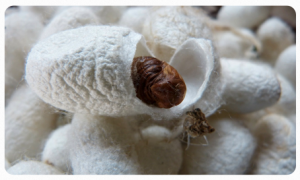
One of the many benefits of sharing the planet with insects is that insects are the source of many valuable commodities that add to the quality of human life. In this chapter and the next, we will look at one of them: silk. It is a commodity that mankind has enjoyed the use of for millennia and we collectively consider them to be a luxury. In this chapter, we will examine silk, with a focus on how and why insects produce it, as well as the uses to which human beings have put silk. As you might expect from an imaginative species such as ours, we have been very inventive in finding ways to employ silk because of its physical qualities, which, in turn, stem from its interesting chemistry. We will also take a look at a very unusual method for harvesting silk and then using it to make a garment that is both profoundly beautiful and a little creepy.
Silk Production in Insects
Let us first consider a definition of silk: it is a lustrous cloth that is produced from the silk produced primarily by a single species of insect, the silk moth, Bombyx mori (Order: Lepidoptera). As noted in Chapter 24, silk moths are grown in culture. In fact, the species has been so thoroughly domesticated it no longer exists in the wild. We owe the silk moth’s introduction to human society to the Chinese who began to culture the moth and use its silk as many as 2,000 years ago. Silk was a highly prized commodity in Chinese society, as it was to become in other cultures when they acquired it. At one time, silk was so valuable that it was literally worth its weight in gold. Further, the techniques for raising the silk worms and producing the silk were top secret. Anyone who breeched the wall of silence around silk production, could be punished by death!
Even if B. mori did exist in nature, we would not use the silk of the wild silk moths. The silk produced by the silk moth is a single strand that it winds up to make a cocoon, inside of which the vulnerable pupal stage will live as it undergoes all of the reorganization necessary to become an adult silk moth. During this time, the pupa is protected by the silk cocoon. When the pupa is ready to eclose to the adult stage, it chews a hole in the cocoon that breaks the silk strand in many places. As a result, silk taken from the wild is of low quality because it no longer consists of a single strand. In addition, it will probably be embedded with dirt, leaves and other detritus as a mechanism to camouflage the cocoon.
The evolution of silk production among the arthropods is a fascinating question in biological history. Arthropods left the waters of the ocean and took their first tentative steps into the terrestrial environment during the geological period known as the Silurian. There were three groups of arthropods that were particularly well-represented during this time: the arachnids, which were primarily scorpions but from which the spiders and mites would later descend; myriapods, which would give rise to millipedes, centipedes; and finally the insects which descended from crustaceans.
Silk production arose several times in the phylum Arthropoda, a further testament to its importance to those that produce it. In all likelihood, the first silk was produced by spiders, possibly in the late Silurian period. Silk production took off after insects hit the scene in the Permian period, where it was rapidly adopted by a variety of insect orders. Insects in the Order Neuroptera (lacewings and antlions) did something truly creative. Instead of excreting nitrogenous wastes through their Malpighian tubules like any self-respecting insect, the larval neuropterans instead converted their nitrogenous wastes into silk! Now that is innovation. Because of its origin as a waste product, the neuropterans bear the distinction of being the only animal, at least that we know about, to spin silk from its anus.
Other insect orders that followed in the Permian period also took up silk-making as a way of life. These innovators included insects in the Order Trichoptera or caddisflies whose larval forms live in bodies of freshwater. The caddisflies enjoyed a major expansion and diversification during the Permian, in part, because of their ability to think of new and creative ways of using silk. Unlike the Neuropterans, the caddisflies dispensed with the ignominious anal route of spinning silk. Instead, the Trichoptera secrete silk through modified salivary glands. Using silk afforded two major advantages to the caddisflies: they could attach a silk thread to a rock and use it as an anchor as they darted out to catch prey or; they would create a tube out of silk impregnated with detritus to make it blend in with the environment to avoid predation. Innovations such as these fueled the diversification of this group even during a time when 11 orders of insects became extinct.
It was an idea that was good enough to be taken up by the true flies (Order Diptera) late in the Permian period. It is true that the idea did not take off among flies to the extent that it did in the caddisflies, but silk was a useful tool in anchoring aquatic larvae to rocks just as it was in caddisflies. This adaptation allowed both groups to invade fast-moving, freshwater habitats where they could feed on algal cells and debris.
Among modern insects, in addition to the aforementioned groups, silk is produced by some lepidopterans in addition to B. mori. Furthermore, some insects in the Order Hymenoptera, such as the relatively primitive sawflies form silk cocoons; and silk serves as a structural element in the nests of a diversity of hymenopterans, e.g., bees, wasps and ants.
Where exactly is the silk produced in the arthropod? As you have already gleaned, it comes from various places. The organ that produces the silk are called the spinnerets, which generally are derived from modified mouth parts and appear in the mouth or are the external portals for silk-producing glands that are housed in the abdomen, as in the case of spiders (Figure 26.1). Silk emanating from spinnerets appears in Figure 26.2 (click on link).
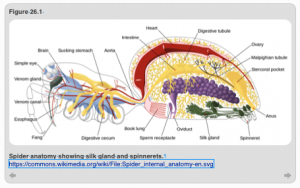
The successes achieved by arthropods that use silk leads ineluctably to the question: why do insects produce silk? In many cases, arthropods are investing a significant proportion of the calories they take in to the production of silk. Thus, it must be the case that silk provides a significant benefit to those that produce it. And the evidence is that silk does provide considerable benefits and, as previously noted, was important enough to drive the evolution of silk-producing groups.
Uses of Silk by Insects
We’ve talked generally about silk in ordinal groups, but let us now look at a few specific examples of how silk is used by lower level groups to earn a living. The sawflies, for instance, use silk to good effect in the same way that silk moths protect themselves during metamorphosis. The sawfly also uses silk to form a cocoon to house the defenseless, immobile pupal stage as it undergoes metamorphosis to the adult stage (Figure 26.3).
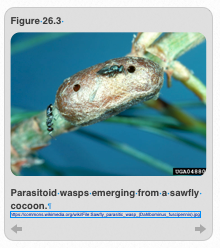
Another lepidopteran (in addition to B. mori), the gypsy moth, produces silk, but uses it in a very different way. The adults have wings but the female doesn’t fly. Distribution of the individuals is centered on moving the larvae around which it does by spinning a strand of silk and using the silk strand to catch a ride on an air wave in a process called ballooning (Figure 26.4 – click on link). It must work pretty well as the gypsy moth is not indigenous to the United States and was imported by a well-meaning physician in Massachusetts who was interested in breeding silk moths. He noted that the silk moths lost vigor the longer they were held in captivity. He thought it would be a great idea to outbreed his silk moths to gypsy moths and imported a bunch of gypsy moths for this purpose. Unfortunately, his facility wasn’t secure, the gypsy moths got loose and, since they were loose in an environment where they lacked indigenous predators and parasites, there were very few controls on gypsy moths in the wild. They have been moving steadily across continental United States ever since, infesting and killing legions of hardwood trees in their wake. Ballooning, thus, appears to be a great dissemination mechanism.
Another use of silk among moth larvae is to anchor a strand of silk to some solid support, e.g., a twig or a leaf and use it as a means for rapidly retracing its steps back to the nest from a feeding site. It is a literal “life line” which, we should note, was first invented by insects. No word on whether bugs have the capacity to “phone a friend.”
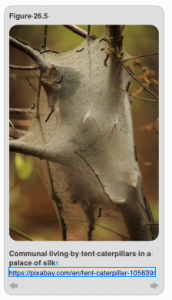
Tent caterpillars, also lepidopterans, have really taken silk to its logical extreme. They get a bunch of caterpillars together and do a group spinning project, the result of which is the production of a massive tent (Figure 26.5). They will find a nice set of branches in a tree and spin a very large silk web in the crotches made by the branches. The result is not good for the tree but it does provide shelter for the larval tent caterpillars, which will help the colony withstand bad environmental conditions such as a significant downpour or a prolonged drought. In addition, the tent provides some protection from predation as long as would-be predators don’t realize that lying underneath the silk is a delicious buffet of caterpillars.
Leaf rollers, also lepidopterans, will take a leaf and wrap it around themselves like a shroud and then anchor the ends of the leaf in place with a strand of silk (Figure 26.6 – click on link). This prevents the leaf from unrolling and provides a protective shelter for the leaf roller inside.
A final use of silk is as a molting pad. As previously mentioned, the pupal stage is highly vulnerable because it is immobile, and the stage may last for quite a long time. Would-be predators are on the lookout for such easy prey. As a result, anything that can be done to reduce the mortality, even if it is not 100% effective, is worth the investment. The molting pad is one such solution. The larval moth will spin silk and use it to attach itself to a branch or twig during the pupal stage. Thus, anchored, it has a better chance of surviving to the adult stage (Figure 26.7).
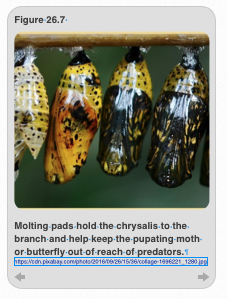
Properties of Silk
Silk owes its properties to the underlying chemistry. It may surprise you to lean that silk is fiber made of protein. On top of that, it is a very simple protein consisting of repeated units of glycine-serine-glycine-alanine. What gives silk its unique properties is that the fiber that comprise silk are arranged in what chemists call beta pleated sheets (Figure 26.8). By putting silk fibers on top of one another, chemical bonds will form between the layered sheets that imparts strength and resiliency to the resulting silk. In addition, if you cut a silk fiber in half, you would see that it is triangular in shape and has the ability to reflect light at many angles. This is responsible for the lustrous, shimmering quality of silk.
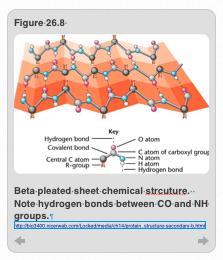
To provide you with a little more information about beta-pleated sheets, please take a look at Figure 26.8. There, you will see two protein fibers or peptides offset by one unit and oriented with one strand on top of the other. This orientation allows low level hydrogen bonds, represented by dashes, to form between the carbonyl or CO group in one strand with amino or NH group in the second strand. Hydrogen bonds are not the strongest type of bond, but when there are many of them, as there are in beta pleated sheets, they can collectively be quite strong. Because of these hydrogen bonds, silk doesn’t stretch. This makes it very attractive as a fabric for clothing since stretching out of shape is one many impediment in clothes made from other substances. In addition the hydrogen bonds make silk more resistant to compressive and shearing forces, which is a benefit to various uses to which silk is put.
Uses of Silk by Humans
As previously mentioned, those uses include clothing where silk is highly valued because it is light weight in addition to retaining its shape. Silk is hypoallergenic and is a great material for making clothes for those who afflicted with allergies. The lustrous quality of the silk also commends it for use in clothing as well as an upholstery material. Because of is resistance to other physical forces, silk has been used extensively for a number of other uses including as the main component in parachutes, and before the advent of rubber, in bicycle tires. Due to its high tensile strength (ability to resist great force without breakage or deformation), silk has been used to make bulletproof vests and for protections against arrows. Silk also found its way into operating rooms in its use as sutures and, of course, silk is a coveted material for use in various forms of visual art. Clearly, many of these uses are obsolete. Rubber has replaced silk in tires. Kevlar is the preferred material in bulletproof vests and synthetic materials are used as sutures. However, silk remains a material of choice for producing beautiful clothing (Figure 26.9).
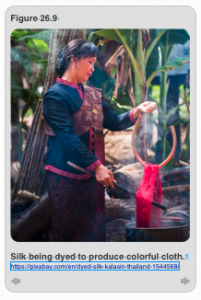
A case in point is provided from a somewhat unusual source. In fact it is so unusual, we might treat it as a bit of a mystery. Let’s say that you’re interested in getting into the silk industry but have decided not to use Bombyx mori as your source of silk. The silk moth is pretty inbred at this point and you think that maybe the quality of the silk would improve if you go with a wild arthropod. But, of course, there would be some major problems with that decision. For instance, you would have to be able to get the silk directly from the source. The quality of silk in cocoons after the insect has emerged is low because evacuating the cocoon creates a hole and severs the silk strand. After lengthy consideration, you think that your business could be based on the beautiful saffron-colored silk produced by the giant orb-weaving spider of Madagascar.
The idea has a lot to recommend it. The orb-weavers grow to about palm size. So, if you are not creeped out by really big spiders, this could be the way to go. Obviously, a big spider will produce a lot of silk, so your yield per individual will be a lot higher than if you were to use silk moths. And, in addition to being a beautiful, unusual color, the silk has five times the tensile strength of steel, which will make it amenable to many diverse uses.
You may have been entranced by the color of the silk, but your business model will face a few challenges. The first problem is that the females, which produce the silk, don’t play well with others. In fact, they are cannibalistic and will eat other females. Thus, it would not be possible to raise large numbers in a colony. Second, the spiders slack off on silk production when the weather gets cold meaning that there will be seasonal aspects to production. Finally, when it rains, the silk produced becomes viscous and is of lower quality. Therefore, your business model must allow for a workforce that has to be prevented from devouring itself. Plus, the spiders will only produce high-quality silk in weather that they like and only then, if it is not raining. But, other than that, it is a sure winner!
Then there are some human factors that will be relevant to the undertaking. The first is that, unlike the United States where it would be difficult to find people who would want to do the necessary work, in Madagascar, there is an abiding belief that the orb-weavers have medicinal value. It is not unusual for natives to catch and fry the spiders up so that they can be eaten to cure maladies such as sore throats. As a result, you will not have to beg human workers to help you procure wild-caught spiders. But, assuming you can get enough spiders to make your business profitable, you will have to convince the spiders to give up their silk and that could be a delicate negotiation. Plus, one imagines that whatever method one had for extracting the silk might require a little practice and entail a learning curve during which a lot of spiders would be injured and silk yield would be low.
Despite these obvious and formidable challenges, British historian and textile expert Simon Peers decided to take on the challenge. As an historian, he had the wherewithal to do research on a very unlikely subject: methods for extracting silk from the Giant Madagascar Orb-Weaving Spider. His research was quickly rewarded with the discovery of a sort of machine that could be used to harness the spiders and then extract silk from their abdomina. His goal was as lofty as it was quixotic: to create a full-sized garment from the saffron silk of the orb weavers.
His next problem was how to procure enough spiders. He recruited a bunch of Madagascar natives to become his spider wranglers. He hired enough people to catch up to 3,000 spiders per day. As an aside, what this says to me is that he basically employed everyone on the island of Madagascar or there are A LOT of really big spiders in Madagascar. Once caught, the workers, all of whom were female, learned how to gently place the spiders in the harness and gently pull a silk sting out of their abdomina without breaking it. Using the harnesses, the workers could “milk” 24 spiders at a time. Each spider would typically yield 400 yards of silk/day. A silk fiber was created by combining 96 threads of silk into a single strand that would become the foundation of the garment made from spider silk. The strands of silk were so strong that not a single strand was broken by the human workers. After extracting the silk, the spiders were released back into the wild so that they could generate more silk if they were caught on another day. This, of course, also prevented cannibalism.
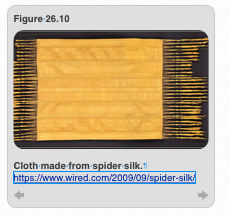
After a number of months of collecting silk, the 96-thread fibers were woven into a beautiful cloth shown in Figure 26.10. It is 11 feet long and was displayed for a while at the Natural History Museum in New York City. We think you’ll have to agree that it is a stunning piece of art. Whether or not Madagascar orb-weaving spiders would make a good business investment is another matter entirely.
One final note of interest when it comes to insects and silk production: there has been a small, but vocal animal rights group who have taken up the cause of silk worms. As you know, when silk moths are raised in culture, we don’t want the adults to emerge from the cocoon, because it ruins the silk. As a result, the cocoons are collected and thrown into boiling water to kill the pupa contained within before it can eclose to the adult. Various people consider this cruel—sort of like what we do to live lobsters before we eat them. One musical group has even composed a song to bring this cruelty to our attention: the 1978 song “Being Boiled” by The Human League is offered as a plea to stop sericulture (rearing of silk moths). You can watch their video on YouTube (Video 26.1).
References
Chapter 26 Cover Photo: Silk cocoon. CC0 Public Domain: LoggaWiggler. Accessed via pixabay.com
Figure 26.1: Spider anatomy. CC-BY 3.0: Pbroks13 (Ryan Wilson); adapted from John Henry Comstock. Accessed via https://commons.wikimedia.org/wiki/File:Spider_internal_anatomy-en.svg
Figure 26.2: Spider spinnerets producing silk. Copyright: Corbis Images. Available at http://www.dailymail.co.uk/sciencetech/article-3312785/Stay-warm-synthetic-spider-s-silk-North-Face-creates-winter-jacket-using-commercial-artificial-proteins.html
Figure 26.3: Sawfly cocoon. CC-BY 3.0: John Ghent. Accessed via https://commons.wikimedia.org/wiki/File:Sawfly_parasitic_wasp_(Dahlbominus_fuscipennis).jpg
Figure 26.4: Balloon gypsy moth larva. Image: Rick Koval. Available at http://www.poconorecord.com/article/20150530/NEWS/150539950
Figure 26.5: Tent caterpillars. CC0 Public Domain: JamesDeMers. Accessed via https://pixabay.com/en/tent-caterpillar-105639/
Figure 26.6: Leaf rollers. Image: Tommi Nyman. Available at http://www.jmeg.fi/IOWleaftiers.htm
Figure 26.7: Molting pads. CC0 Public Domain: skeeze. Accessed via https://cdn.pixabay.com/photo/2016/09/26/15/36/collage-1696221_1280.jpg
Figure 26.8: Beta pleated sheet. Image: author unknown. Accessed via http://bio3400.nicerweb.com/Locked/media/ch14/protein_structure-secondary-b.html
Figure 26.9: Dyeing silk. CC0 Public Domain: Tedd. Accessed via https://pixabay.com/en/dyed-silk-kalasin-thailand-1544568/
Figure 26.10: Spider silk cloth. Image: author unknown. Accessed via https://www.wired.com/2009/09/spider-silk/
Video 26.1: Boiled alive by The Human League. Available at https://www.youtube.com/watch?v=I_NStTkSRQw
Additional Readings
Scott, P. (2001). The Book of Silk. Thames & Hudson; Revised ed. edition (October 2001), 256 pages.
Vollrath, F. and D. Knight (2005). The Biology and Technology of Silk Production Wiley-Verlag online: DOI: 10.1002/3527600035.bpol8002, pp. 26-44.